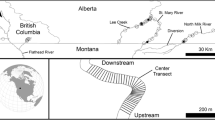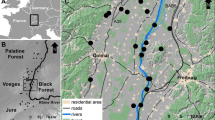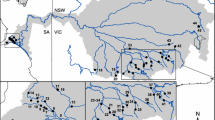Abstract
Aquatic systems have been extensively altered by human structures (e.g., construction of dams/canals) and these have major impacts on the connectivity of wildlife populations through the loss and isolation of suitable habitats. Habitat loss and isolation affect gene flow and influence the persistence of populations in time and space by restricting movements. Isolation can result in higher inbreeding, lower genetic diversity, and greater genetic structure, which may render populations more vulnerable to environmental changes, and thus to extinction. Given the ubiquity and the persistence of dams and canals in space and time, it is crucial to understand their effects on the population genetics of aquatic species. Here, we documented the genetic diversity and structure of painted turtle (Chrysemys picta) populations in the Rideau Canal, Ontario, Canada. More specifically, we used 13 microsatellites to evaluate the influence of locks on genetic variation in 822 painted turtles from 22 sites evenly distributed along the 202-km canal. Overall, we found low, but significant, genetic differentiation suggesting that some dispersal is occurring throughout the canal. In addition, we showed that locks contribute to the genetic differentiation observed in the system. Clustering analysis revealed two distinct genetic groups whose boundary is associated with a series of six locks. Our results illustrate how artificial waterways, such as canal systems, can influence population genetic structure. We highlight the importance of adopting management plans that can mitigate the impacts of human infrastructure and preserve gene flow across the landscape to maintain viable populations.


Similar content being viewed by others
Data availability
All data collected and analysed during this study are available in the Zenodo Digital Repository: https://doi.org/10.5281/zenodo.5826150
Code availability
All R codes used for this study are available in the Zenodo Digital Repository: https://doi.org/10.5281/zenodo.5826150
References
Adamack AT, Gruber B (2014) PopGenReport: simplifying basic population genetic analyses in R. Methods Ecol Evol 5:384–387. https://doi.org/10.1111/2041-210X.12158
Alcala N, Goudet J, Vuilleumier S (2014) On the transition of genetic differentiation from isolation to panmixia: what we can learn from GST and D. Theor Popul Biol 93:75–84. https://doi.org/10.1016/j.tpb.2014.02.003
Aljanabi SM, Martinez I (1997) Universal and rapid salt-extraction of high quality genomic DNA for PCR-based techniques. Nucleic Acids Res 25:4692–4693. https://doi.org/10.1093/nar/25.22.4692
Alp M, Keller I, Westram AM, Robinson CT (2012) How river structure and biological traits influence gene flow: a population genetic study of two stream invertebrates with differing dispersal abilities. Freshw Biol 57:969–981. https://doi.org/10.1111/j.1365-2427.2012.02758.x
Avise JC, Bowen BW, Lamb T et al (1992) Mitochondrial DNA evolution at a turtle’s pace: evidence for low genetic variability and reduced microevolutionary rate in the Testudines. Mol Biol Evol 9:457–473. https://doi.org/10.1093/oxfordjournals.molbev.a040735
Barbarossa V, Schmitt RJP, Huijbregts MAJ et al (2020) Impacts of current and future large dams on the geographic range connectivity of freshwater fish worldwide. Proc Natl Acad Sci USA 117:3648–3655. https://doi.org/10.1073/pnas.1912776117
Bates D, Maechler M, Bolker B, Walker S (2015) Fitting linear mixed-effects models using lme4. J Stat Softw 67:1–48. https://doi.org/10.18637/jss.v067.i01
Benjamini Y, Yekutieli D (2001) The control of the false discovery rate in multiple testing under dependency. Ann Stat 29:1165–1188. https://doi.org/10.1214/aos/1013699998
Bennett AM, Keevil M, Litzgus JD (2010) Spatial ecology and population genetics of northern map turtles (Graptemys geographica) in fragmented and continuous habitats in Canada. Chelonian Conserv Biol 9:185–195. https://doi.org/10.2744/CCB-0824.1
Bergman JN, Beaudoin C, Mistry I et al (2021) Historical, contemporary, and future perspectives on a coupled social-ecological system in a changing world: Canada’s historic Rideau Canal. Environ Rev. https://doi.org/10.1139/er-2021-0026
Böhm M, Collen B, Baillie JEM et al (2013) The conservation status of the world’s reptiles. Biol Conserv 157:372–385. https://doi.org/10.1016/j.biocon.2012.07.015
Bowne DR (2002) Linking individual behaviour to population processes at the landscape level. Dissertation, University of Virginia
Bowne DR (2008) Terrestrial activity of Chrysemys picta in northern Virginia. Copeia 2008:306–310. https://doi.org/10.1643/CE-06-224
Bowne DR, White HR (2004) Searching strategy of the painted turtle Chrysemys picta across spatial scales. Anim Behav 68:1401–1409. https://doi.org/10.1016/j.anbehav.2004.01.018
Brooks RJ, Brown GP, Galbraith DA (1991) Effects of a sudden increase in natural mortality of adults on a population of the common snapping turtle (Chelydra serpentina). Can J Zool 69:1314–1320. https://doi.org/10.1139/z91-185
Buhlmann KA, Akre TSB, Iverson JB et al (2009) A global analysis of tortoise and freshwater turtle distributions with identification of priority conservation areas. Chelonian Conserv Biol 8:116–149. https://doi.org/10.2744/CCB-0774.1
Bulté G, Carrière M-A, Blouin-Demers G (2010) Impact of recreational power boating on two populations of nothern map turtles. Aquat Conserv Mar Freshw Ecosyst 20:31–38. https://doi.org/10.1002/aqc
Carvajal-Quintero JD, Januchowski-Hartley SR, Maldonado-Ocampo JA et al (2017) Damming fragments species’ ranges and heightens extinction risk. Conserv Lett 10:708–716. https://doi.org/10.1111/conl.12336
Clarke RT, Rothery P, Raybould AF (2002) Confidence limits for regression relationships between distance matrices: estimating gene flow with distance. J Agric Biol Environ Stat 7:361–372. https://doi.org/10.1198/108571102320
Congdon JD, Dunham AE, Van Loben Sels RC (1994) Demographics of common snapping turtles (Chelydra serpentina): implications for conservation and management of long-lived organisms. Integr Comp Biol 34:397–408. https://doi.org/10.1093/icb/34.3.397
COSEWIC (2018) COSEWIC assessment and status report on the Midland Painted Turtle Chrysemys picta marginata and the Eastern Painted Turtle Chrysemys picta picta in Canada. Committee on the Status of Endangered Wildlife in Canada. https://www.registrelep-sararegistry.gc.ca/virtual_sara/files/cosewic/srMidlandPaintedTurtleEasternPaintedTurtle2018e.pdf. Accessed 28 June 2021
Dupuis-Desormeaux M, Davy C, Lathrop A et al (2018) Colonization and usage of an artificial urban wetland complex by freshwater turtles. PeerJ 2018:1–23. https://doi.org/10.7717/peerj.5423
Ernst CH, Lovich JE (2009) Turtles of the United States and Canada. The Johns Hopkins University Press, Baltimore
Evanno G, Regnaut S, Goudet J (2005) Detecting the number of clusters of individuals using the software STRUCTURE: a simulation study. Mol Ecol 14:2611–2620. https://doi.org/10.1111/j.1365-294X.2005.02553.x
Fahrig L (2003) Effects of habitat fragmentation on biodiversity. Annu Rev Ecol Evol Syst 34:487–515. https://doi.org/10.1146/annurev.ecolsys.34.011802.132419
Fraik AK, McMillan JR, Liermann M et al (2021) The impacts of dam construction and removal on the genetics of recovering steelhead (Oncorhynchus mykiss) populations across the Elwha river watershed. Genes 12:89. https://doi.org/10.3390/genes12010089
Frankham R (1996) Relationship of genetic variation to population size in wildlife. Conserv Biol 10:1500–1508. https://doi.org/10.1046/j.1523-1739.1996.10061500.x
Fuller MR, Doyle MW, Strayer DL (2015) Causes and consequences of habitat fragmentation in river networks. Ann N Y Acad Sci 1355:31–51. https://doi.org/10.1111/nyas.12853
Gibbons JW, Scott DE, Ryan TJ et al (2000) The global decline of reptiles, Déjà vu Amphibians. Bioscience 50:653–666. https://doi.org/10.1641/0006-3568(2000)050[0653:TGDORD]2.0.CO;2
Grill G, Lehner B, Lumsdon AE et al (2015) An index-based framework for assessing patterns and trends in river fragmentation and flow regulation by global dams at multiple scales. Environ Res Lett 10:015001. https://doi.org/10.1088/1748-9326/10/1/015001
Gustafson KD, Gagne RB, Vickers TW et al (2019) Genetic source–sink dynamics among naturally structured and anthropogenically fragmented puma populations. Conserv Genet 20:215–227. https://doi.org/10.1007/s10592-018-1125-0
Haddad NM, Brudvig LA, Clobert J et al (2015) Habitat fragmentation and its lasting impact on Earth’s ecosystems. Sci Adv 1:e1500052. https://doi.org/10.1126/sciadv.1500052
Hailer F, Helander B, Folkestad AO et al (2006) Bottlenecked but long-lived: High genetic diversity retained in white-tailed eagles upon recovery from population decline. Biol Lett 2:316–319. https://doi.org/10.1098/rsbl.2006.0453
Hedrick PW (2005) A standardized genetic differentiation measure. Evolution 59:1633–1638. https://doi.org/10.1111/j.0014-3820.2005.tb01814.x
Holderegger R, Wagner HH (2008) Landscape genetics. Bioscience 58:199–207. https://doi.org/10.1016/B978-0-12-384719-5.00386-5
Jansson R, Nilsson C, Renöfält B (2000) Fragmentation of riparian floras in rivers with multiple dams. Ecology 81:899–903. https://doi.org/10.1890/0012-9658(2000)081[0899:FORFIR]2.0.CO;2
Jonsson N (1991) Influence of water flow, water temperature and light on fish migration in rivers. Nord J Freshw Resour 66:20–35
Junker J, Peter A, Wagner CE et al (2012) River fragmentation increases localized population genetic structure and enhances asymmetry of dispersal in bullhead (Cottus gobio). Conserv Genet 13:545–556. https://doi.org/10.1007/s10592-011-0306-x
Kamvar ZN, Tabima JF, Grünwald NJ (2014) Poppr: an R package for genetic analysis of populations with clonal, partially clonal, and/or sexual reproduction. PeerJ 2:e281. https://doi.org/10.7717/peerj.281
Keenan K, McGinnity P, Cross TF et al (2013) diveRsity: an R package for the estimation of population genetics parameters and their associated errors. Methods Ecol Evol 4:782–788. https://doi.org/10.1111/2041-210X.12067
Kopelman NM, Mayzel J, Jakobsson M et al (2015) Clumpak: a program for identifying clustering modes and packaging population structure inferences across K. Mol Ecol Resour 15:1179–1191. https://doi.org/10.1111/1755-0998.12387
Koschorreck M, Downing AS, Hejzlar J et al (2020) Hidden treasures: human-made aquatic ecosystems harbour unexplored opportunities. Ambio 49:531–540. https://doi.org/10.1007/s13280-019-01199-6
Kuo C-H, Janzen FJ (2004) Genetic effects of a persistent bottleneck on a natural population of ornate box turtles (Terrapene ornata). Conserv Genet 5:425–437. https://doi.org/10.1023/B:COGE.0000041020.54140.45
Laporte M, Silva Beaudry C-O, Angers B (2013) Effects of road proximity on genetic diversity and reproductive success of the painted turtle (Chrysemys picta). Conserv Genet 14:21–30. https://doi.org/10.1007/s10592-0s12-0419-x
Legget RF (1986) Rideau waterway, vol 3. University of Toronto Press, Toronto
Leigh DM, Hendry AP, Vázquez-Domínguez E, Friesen VL (2019) Estimated six per cent loss of genetic variation in wild populations since the industrial revolution. Evol Appl 12:1505–1512. https://doi.org/10.1111/eva.12810
Lenormand T (2002) Gene flow and the limits to natural selection. Trends Ecol Evol 17:183–189. https://doi.org/10.1111/j.1365-2184.1976.tb01248.x
Lin HY, Cooke SJ, Wolter C et al (2020) On the conservation value of historic canals for aquatic ecosystems. Biol Conserv 251:108764. https://doi.org/10.1016/j.biocon.2020.108764
Lippé C, Dumont P, Bernatchez L (2006) High genetic diversity and no inbreeding in the endangered copper redhorse, Moxostoma hubbsi (Catostomidae, Pisces): the positive sides of a long generation time. Mol Ecol 15:1769–1780. https://doi.org/10.1111/j.1365-294X.2006.02902.x
Liu X, Wu R, Chen X et al (2020) Effects of dams and their environmental impacts on the genetic diversity and connectivity of freshwater mussel populations in Poyang Lake Basin, China. Freshw Biol 65:264–277. https://doi.org/10.1111/fwb.13419
Lowe WH, Allendorf FW (2010) What can genetics tell us about population connectivity? Mol Ecol 19:3038–3051. https://doi.org/10.1111/j.1365-294X.2010.04688.x
Lüdecke D (2018) ggeffects: tidy data frames of marginal effects from regression models. J Open Sour Softw 3:772. https://doi.org/10.21105/joss.00772
Manel S, Schwartz MK, Luikart G, Taberlet P (2003) Landscape genetics: combining landscape ecology and population genetics. Trends Ecol Evol 18:189–197. https://doi.org/10.1016/S0169-5347(03)00008-9
Midwood JD, Cairns NA, Stoot LJ et al (2015) Bycatch mortality can cause extirpation in four freshwater turtle species. Aquat Conserv Mar Freshw Ecosyst 25:71–80. https://doi.org/10.1002/aqc.2475
Morjan CL, Rieseberg LH (2004) How species evolve collectively: implications of gene flow and selection for the spread of advantageous alleles. Mol Ecol 13:1341–1356. https://doi.org/10.1111/j.1365-294X.2004.02164.x
Nagle RD, Kinney OM, Gibbons JW, Congdon JD (2017) A simple and reliable system for marking hard-shelled turtles: the North American Code. Herpetol Rev 48:327–330
Nilsson C (2005) Fragmentation and flow regulation of the world’s large river systems. Science 308:405–408. https://doi.org/10.1126/science.1107887
Paradis E (2010) Pegas: an R package for population genetics with an integrated–modular approach. Bioinformatics 26:419–420. https://doi.org/10.1093/bioinformatics/btp696
Parks Canada (2006) Nomination of the Rideau Canal by the Government of Canada, 2006 for the Inscription on the Word Heritage List. https://whc.unesco.org/uploads/nominations/1221.pdf. Accessed 28 June 2021
Peakall R, Smouse PE (2012) GenAlEx 6.5: genetic analysis in Excel. Population genetic software for teaching and research-an update. Bioinformatics 28:2537–2539. https://doi.org/10.1093/bioinformatics/bts460
Perkin JS, Gido KB (2012) Fragmentation alters stream fish community structure in dendritic ecological networks. Ecol Appl 22:2176–2187. https://doi.org/10.1890/12-0318.1
Porras-Hurtado L, Ruiz Y, Santos C et al (2013) An overview of STRUCTURE: applications, parameter settings, and supporting software. Front Genet 4:1–13. https://doi.org/10.3389/fgene.2013.00098
Pritchard JK, Stephens M, Donnelly P (2000) Inference of population structure using multilocus genotype data. Genetics 155:945–959
R Core Team (2019) R: a language and environment for statistical computing. R Foundation for Statistical Computing, Vienna, Austria. https://www.R-project.org/. Accessed 28 June 2021
Reed DH, Frankham R (2003) Correlation between fitness and genetic diversity. Conserv Biol 17:230–237. https://doi.org/10.1046/j.1523-1739.2003.01236.x
Reid BN, Peery MZ (2014) Land use patterns skew sex ratios, decrease genetic diversity and trump the effects of recent climate change in an endangered turtle. Divers Distrib 20:1425–1437. https://doi.org/10.1111/ddi.12243
Reid BN, Mladenoff DJ, Peery MZ (2017) Genetic effects of landscape, habitat preference and demography on three co-occurring turtle species. Mol Ecol 26:781–798. https://doi.org/10.1111/mec.13962
Reid SM, Wilson CC, Carl LM, Zorn TG (2008) Species traits influence the genetic consequences of river fragmentation on two co-occurring redhorse (Moxostoma) species. Can J Fish Aquat Sci 65:1892–1904. https://doi.org/10.1139/F08-093
Roberts JH, Angermeier PL, Hallerman EM (2013) Distance, dams and drift: what structures populations of an endangered, benthic stream fish? Freshw Biol 58:2050–2064. https://doi.org/10.1111/fwb.12190
Row JR, Knick ST, Oyler-McCance SJ et al (2017) Developing approaches for linear mixed modeling in landscape genetics through landscape-directed dispersal simulations. Ecol Evol 7:3751–3761. https://doi.org/10.1002/ece3.2825
Schlaepfer DR, Braschler B, Rusterholz HP, Baur B (2018) Genetic effects of anthropogenic habitat fragmentation on remnant animal and plant populations: a meta-analysis. Ecosphere 9:e02488. https://doi.org/10.1002/ecs2.2488
Schmidt C, Domaratzki M, Kinnumen RP et al (2020) Continent-wide effects of urbanization on bird and mammal genetic diversity. Proc R Soc B 287:20192497. https://doi.org/10.1101/2020.08.16.253104
Seburn DC (2015) Distribution of the exotic pond slider (Trachemys scripta) in Ontario. Can Field-Nat 129:342–348. https://doi.org/10.22621/cfn.v129i4.1756
Selkoe KA, Scribner KT, Galindo HM (2015) Waterscape genetics - applications of landscape genetics to rivers, lakes, and seas. In: Balkenhol N et al (eds) Landscape genetics: concepts, methods, applications. Wiley Blackwell, Oxford, pp 220–246
Semlitsch RD, Bodie JR (2003) Biological criteria for buffer zones around wetlands and riparian habitats for amphibians and reptiles. Conserv Biol 17:1219–1228. https://doi.org/10.1046/j.1523-1739.2003.02177.x
Shaffer HB, Minx P, Warren DE et al (2013) The western painted turtle genome, a model for the evolution of extreme physiological adaptations in a slowly evolving lineage. Genome Biol 14:R28. https://doi.org/10.1186/gb-2013-14-3-r28
Spear MJ, Elgin AK, Grey EK (2018) Current and projected distribution of the red-eared slider turtle, Trachemys scripta elegans, in the great lakes basin. Am Midl Nat 179:191–221. https://doi.org/10.1674/0003-0031-179.2.191
Steen DA, Gibbs JP, Buhlmann KA et al (2012) Terrestrial habitat requirements of nesting freshwater turtles. Biol Conserv 150:121–128. https://doi.org/10.1016/j.biocon.2012.03.012
Su G, Logez M, Xu J et al (2021) Human impacts on global freshwater fish biodiversity. Science 371:835–838. https://doi.org/10.1126/science.abd3369
Su J, Yan Y, Song J et al (2018) Recent fragmentation may not alter genetic patterns in endangered long-lived species: evidence from taxus cuspidata. Front Plant Sci 871:1571. https://doi.org/10.3389/fpls.2018.01571
Sundqvist L, Keenan K, Zackrisson M et al (2016) Directional genetic differentiation and relative migration. Ecol Evol 6:3461–3475. https://doi.org/10.1002/ece3.2096
Sutherland H (2017) Great expectations for biopassage innovation in design of a turtle passage at gympie weir. The Australian National Committee on Large Dams Incorporated. https://www.ancold.org.au/?product=2017-great-expectations-for-biopassage-innovation-in-design-of-a-turtle-passage-at-gympie-weir. Accessed 28 June 2021
Thioulouse J, Dray S, Dufour A et al (2018) Multivariate analysis of ecological data with ade4. Springer, Berlin
Tulloch J (1981) The Rideau Canal: defence, transport, and recreation, vol 50. National Historic Parks and Sites Branch. Parks Canada, Hull
Van Dijk PP (2011) Chrysemys picta (errata version published in 2016). IUCN Red List Threat Species 2011:e.T163467A97410447. https://doi.org/10.2305/IUCN.UK.2011-1.RLTS.T163467A5608383.en
Van Strien MJ, Keller D, Holderegger R (2012) A new analytical approach to landscape genetic modelling: least-cost transect analysis and linear mixed models. Mol Ecol 21:4010–4023. https://doi.org/10.1111/j.1365-294X.2012.05687.x
Vergeynst J, Pauwels I, Baeyens R et al (2019) The impact of intermediate-head navigation locks on downstream fish passage. River Res Appl 35:224–235. https://doi.org/10.1002/rra.3403
Verhelst P, Baeyens R, Reubens J et al (2018) European silver eel (Anguilla anguilla L.) migration behaviour in a highly regulated shipping canal. Fish Res 206:176–184. https://doi.org/10.1016/j.fishres.2018.05.013
Wagner H (2020) LandGenCourse: interface for course "landscape genetic data analysis with R". R package version 1.4.4
Watson KW (2006) Engineered landscapes. Ken W. Watson, Elgin
Weir BS, Cockerham CC (1984) Estimating F-statistics for the analysis of population structure. Evolution 38:1358–1370. https://doi.org/10.2307/2408641
Wickham H (2016) ggplot2: elegant graphics for data analysis. Springer, New York
Willi Y, Van Buskirk J, Hoffmann AA et al (2006) Limits to the adaptive potential of small populations. Annu Rev Ecol Evol Syst 37:433–458. https://doi.org/10.1146/annurev.ecolsys.37.091305.110145
Willoughby JR, Sundaram M, Lewis TL, Swanson BJ (2013) Population decline in a long-lived species: the wood turtle in Michigan. Herpetologica 69:186–198. https://doi.org/10.1655/HERPETOLOGICA-D-12-00033R2
WWF (2018) Living Planet Report - 2018: aiming higher. In: Grooten M, Almond REA (eds) WWF, Gland
Acknowledgements
We thank all field assistants who helped with field data collection and Carolyne Houle who helped with the genetic analyses. Valerie Minelga and Chantal Vis from Parks Canada Agency provided access to data on lockage activities and comments/suggestions on the manuscript. This project is part of a large collaborative initiative led by Steven J. Cooke from Carleton University.
Funding
This work was supported by a Natural Sciences and Engineering Research Council of Canada (NSERC) Strategic Project Grant on the Rideau Canal. AT was supported by a postgraduate NSERC scholarship.
Author information
Authors and Affiliations
Contributions
All authors contributed to the study conception and design. Material preparation, data collection, and data analysis were performed by AT. The first draft of the manuscript was written by AT and all authors commented on subsequent versions of the manuscript. All authors read and approved the final manuscript.
Corresponding author
Ethics declarations
Conflict of interest
The authors declare no conflict of interest.
Ethical approval
All protocols were approved by animal care committees at the University of Ottawa (protocol BL-3008) and Queen’s University (protocol 2018-1836). All fieldwork was carried out under a Parks Canada Agency research and collection permit (number RIC-2018-29178) and Wildlife Scientific Collector’s Authorizations from the Ontario Ministry of Natural Resources (numbers 1089358, 1092637 and 1095459).
Consent to participate and publish
All authors agree to participate and to publish the produced data of this research.
Additional information
Publisher's Note
Springer Nature remains neutral with regard to jurisdictional claims in published maps and institutional affiliations.
Supplementary Information
Below is the link to the electronic supplementary material.
Rights and permissions
About this article
Cite this article
Turcotte, A., Blouin-Demers, G. & Garant, D. Exploring the effect of 195 years-old locks on species movement: landscape genetics of painted turtles in the Rideau Canal, Canada. Conserv Genet 23, 467–479 (2022). https://doi.org/10.1007/s10592-022-01431-z
Received:
Accepted:
Published:
Issue Date:
DOI: https://doi.org/10.1007/s10592-022-01431-z




